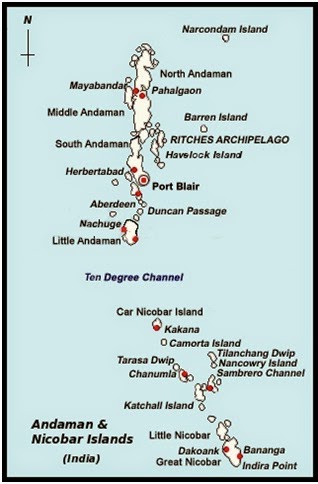We
all know India possesses an exuberant range of flora and an extravagant
diversity of fauna. But do you really know the extent of the richness?
Do we know that India is loaded with diversity on the terrestrial front
as well as underwater life? With the stronghold of industrialization
increasing everyday and invading every biosphere of our planet there is
destruction of many underwater marvels. But India still has places where
one can marvel at the bounty of nature's creation.
Andaman
and Nicobar Islands is an archipelago in the Bay of Bengal and belong
to the Indian state. These are home to many tribes which have retained
their origin and have not been affected by modernisation. Many of them
provide links to the evolutionary lineages so important to biologists
and clues to social behaviour which are significant for the study of
anthropology and some. Now, because of India's strict policies on
protection of environment Andaman boasts of one of the last remaining
frontiers for diving in the world.
HOW TO GET THERE
The
Andaman and Nicobar Islands are a group of 600 tiny rock like islands
jutting out of the great Bay of Bengal. The capital Port Blair is like
the door to the secrets of this unexplored archipelago. The airstrip at
Port Blair has flights from almost all major cities of India and many
airlines offer discounts during the holiday season also the sea way is
another option of reaching the unprecedented shores of the group of
mysterious islands down south. The cruises take a lot of time to get you
there but the journey and the scenes from aboard the ships are worth
the time. The ferries depart from the port towns of Kolkata and Chennai
and some.
Once
in Port Blair and after acquiring your Restricted Travel Permit, if you
are a non-Indian, you can see the locales by hiring taxis or autos,
which double up as guides, or by renting out a scooter or bike. Ferries
leave for other islands such as Havelock, Mahatma Gandhi Marine National
Park, Neil Island etc. Since it's not permitted to go ashore on may
islands like the Sentinel Island, live-aboard are available for taking
you to indulge in scuba diving, snorkelling etc.
BEST TIME
Located
in the middle of a sea and having seen the worst natural disaster on
Boxing Day of 2004, these islands take a beating from the sea almost all
year round. But one should especially avoid going there in the monsoons
i.e. from May till July as the sky is full of clouds with furious winds
and incessant rainfall making visibility underwater very less. There
are occasional showers from August to November but one can still dive
deep to explore the underworld, the weather takes a turn for the worst
in December to early January. The sea is rough with chances of storms
and hurricanes.
Basically,
the best months to make the trip down there is from January to May,
when the weather is sunny and the waters so calm that you can see the
lovely fleece clouds being reflected in the water.
DIVE SITES
As
the islands are scattered in the Bay of Bengal there is no one place
for scuba diving. Each island has something different to offer. Based on
the islands accessible and those which are restricted there are some
choice diving sites. For some you can go on shore and enjoy the
beautiful beaches while for others you have to take the live-aboard in
which a ferry takes you to the dive site and you have to dive from the
boat itself.
Havelock
Island is an island with pristine beaches where you can de-board and
enjoy at the resorts. Bala Reef, Corruption Rock, Snake Island, etc. are
some other dive sites around Andaman where you can enjoy emerald waters
and an underwater visibility of 80ft. Barren Island is a stunning place
for diving. The only active volcano of south Asia is boiling here.
There are also World War II wreck sites which form interesting and fun
dive sites.
Fish island, North Cinque, Sisters Island, Snake Island, Passage Island, Neil Island, etc. are some other famous and interesting dive spots.
Fish island, North Cinque, Sisters Island, Snake Island, Passage Island, Neil Island, etc. are some other famous and interesting dive spots.
WHAT TO EXPECT
For
best diving experience one should go to Barren Island and Narcondum
Island (which is an extinct volcano). There are hills of volcanic lava
formed around which the reefs thrive with life as you never expected to
see. You can expect to see a burst of colour in the form of the coral
formed over the years. You can see barracudas, tunas, manta rays, and
many other fishes in and around the corals. Leapord sharks, schools of
hammerheads and, if you are really lucky, turtles can be spotted around
the great, hard reefs. You can also go for night time diving at the
Lighthouse at the Havelock Island and enjoy the phosphorescent sea!
There
are dive schools as well as dive shops which provide the equipment and
training for beginners as well as seasoned divers, alike. But you should
still check to make sure that the equipment is in sublime condition.
Also as responsible citizens it is your duty to help maintain the beauty
of the reefs. Do not touch the corals as the formation of a reef is not
a overnight phenomena but a long process over the years. The nature
does not work for your whims and fancies so take care that you don't
move any underwater treasure to get a perfect profile picture.
Take
special care to avoid any littering on the beaches or underwater. We
are sure you wouldn't like someone coming over and creating a mess at
your place, right? The marine flora and fauna live in a very delicate
ecosystem and a stray packet of wafers can be pretty destructive to
their residences.







Comments
Post a Comment